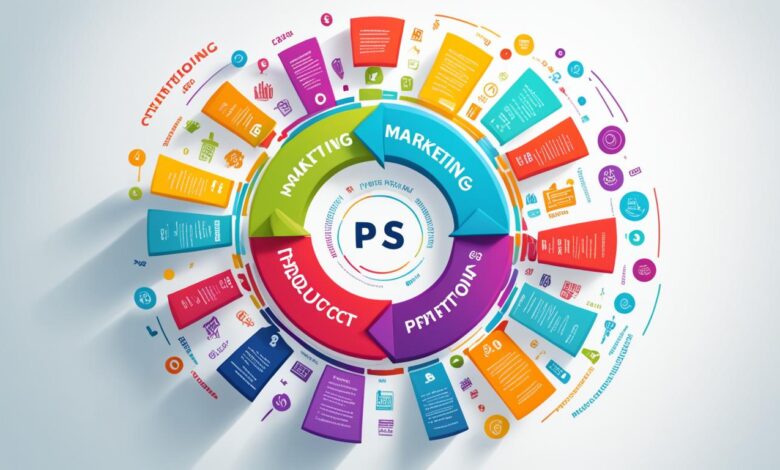Essentials of Understanding Marketing Fundamentals

Did you know that 80% of small businesses fail within their first 18 months? In today’s competitive world, knowing marketing well is key. This guide is for both beginners and pros. It shares the basic and important parts of marketing.
Ready to learn how marketing can boost your business? Let’s get started!
What is Marketing?
Marketing is what businesses do to make their products or services known. They try to get customers to buy what they’re selling. This means doing things like market research, coming up with ads, deciding on prices, and how the items will get to customers.
Marketing focuses on connecting with people who might want to buy. It aims to get them interested so they actually make a purchase. This is done through different methods to persuade and attract them.
Marketing is both art and science, using skills and methods to show why products or services are valuable.
Marketing aims to please customers by understanding and meeting their needs. It’s about developing a good relationship with them. This helps keep the customers happy and interested in buying.
Marketing is about planning and putting those plans into action. It involves knowing a lot about who might buy, what the competition is doing, and how the market is changing. It means constantly watching and adjusting to what’s happening in the market.
Here’s a marketing example: A new fashion brand looks at what’s trendy, what customers like, and what others are offering. They then launch a campaign to show off their unique clothes, emphasizing what’s cool and special about them.
They use ads, social media, and other ways to tell their target customers about the clothes. This encourages their customers to buy, boosting their sales.
Marketing as Value Creation
Marketing’s main aim is not just to sell stuff but to add value for customers. It involves understanding what customers are looking for and crafting messages that speak to them.
- It’s all about meeting the customers’ specific needs and making sure the products bring real benefits.
- They create strategies focused on strong relationships and keeping customers coming back.
The Marketing Mix: A Framework for Success
The marketing mix includes the four essential parts of a strategy:
- Product: This is what the company is offering. It includes everything from what the items look like to what they can do.
- Price: Figuring out how to price things is key. It involves looking at what the market wants, what competitors are doing, and what value the product brings.
- Promotion: Various ways are used to get people to notice and want what’s being sold. These include ads, events, special deals, and digital campaigns.
- Place: This is how and where the items are sold. It’s about managing stock, shipping, and making sure it’s easy for people to buy.
Marketers work on these areas to build a strategy that meets what customers want. This creates value and helps the business do well.
Understanding the Marketing Mix and the 4 P’s of Marketing
Marketing is all about mixing four key elements: product, price, promotion, and place. When combined, these make up the marketing mix. This mix guides everything marketers do.
The product is what your company sells. This includes its features, how it looks, and its packaging. A good product meets what the people want. It’s important to know your audience’s tastes to do this right.
The price shows how much the customer has to pay. It includes thinking about the product’s value, and looking at what others are charging. Choosing the right price is key to pulling in customers and making money.
Promotion covers all the ways you tell people about your product. This can be through ads, PR, or special deals. A strong promotion helps your product standout, teach people what’s great about it, and why they should buy it.
Place means making sure customers can easily buy your product. This includes choosing the best ways to get it to people. Whether it’s online, in a store, or through someone else, its availability matters a lot.
To succeed in marketing, you must get the marketing mix right. By focusing on the product, its price, how you promote it, and where you sell it, you can make a plan that really meets the customer’s needs.
Key Areas of Modern Marketing to Understand
Modern marketing has several crucial areas for businesses to stay competitive. These areas are vital in today’s digital world.
Content marketing is focused on creating valuable and informative content. This content engages and educates audiences. By offering useful information and solving problems, businesses earn trust.

Email marketing is vital for its high ROI and conversion rates. Businesses use personalized emails to nurture leads and build strong relationships. This method also encourages repeat purchases.
Social media marketing helps businesses build brand awareness and reach new customers. Facebook, Instagram, and Twitter are key for advertising and engagement.
Video marketing online is becoming more popular. It takes advantage of platforms like YouTube. Making engaging videos helps businesses connect with their audience better.
Businesses can also use advertising and pay-per-click (PPC) to promote products. These methods target specific audiences based on their interests and behaviors.
Search engine optimization (SEO) is vital as it enhances a business’s website visibility. Optimizing website and content improves rankings, attracting more visitors.
Public relations
is crucial for managing relationships and brand image. By fostering good ties with media, influencers, and the public, businesses improve their reputation.
- Influencer marketing
leverages social media influencers to reach a wider audience. Partnering with influencers can significantly raise brand awareness and boost sales.
Developing a well-rounded marketing strategy is necessary to succeed. Including content, email, and social media marketing, as well as video marketing, SEO, and public relations, helps businesses effectively engage their audience. This helps achieve their marketing objectives and fuel growth.
Developing a Marketing Strategy
Creating a marketing strategy is key to reaching your marketing goals. First, you find your audience and learn what they want. Then, you decide what actions you want these customers to take. This marketing strategy guides your efforts so they support your business goals.
Finding your target audience is a major part of this process. You need to know your customers and what they need. This way, your marketing can really connect with them. To do this, you research and study their traits, behaviors, and preferences.
After defining your audience, you need clear marketing goals. These goals should be smart: specific, measurable, attainable, relevant, and time-bound. Clear goals focus your efforts. They also help you see if your marketing is working.
Having an action plan in your strategy is vital. This plan details your tactics, where and how you’ll market, and what you’ll say or show. It should cover everything from ads to how you handle customer relationships.
“A marketing strategy without measurement is like sailing without a compass. It’s crucial to track key performance indicators (KPIs). This helps you understand your marketing’s impact and make decisions that are backed by data.”
Measuring your marketing’s effects is essential. You look at metrics like website visitors, how many customers you get, and what each customer is worth. This data tells you what’s working and what isn’t. Then, you can tweak your strategy to get better results.
Creating a marketing strategy takes time, research, and planning. It’s your roadmap for all marketing work. By reviewing your strategy regularly and making changes based on what you learn, you can see real marketing success.
Getting to Know Your Audience
It’s key to know your audience well for successful marketing. You need to understand their needs and preferences clearly. Market research helps with this. It lets you dive into who your audience is, what they like, and how they shop.
Segmenting Your Target Audience
By breaking down your audience into specific groups, you can target better. You look at things like age, gender, income, and education. This helps make your marketing hit home for each group.
Market research is essential in this process. It shows you who your customers really are. With surveys and data, you spot trends and learn about your different audiences.
Effective customer segmentation means putting your marketing focus where it matters most.
Understanding Demographics and Psychographics
Demographics give you the hard facts about your audience. They tell you age, gender, and more. All this data helps you know what they can afford and what they might like.
Psychographics jump into what makes your audience tick. It’s about their personalities, values, and lifestyle. Knowing this helps you connect with them on a deeper level through your marketing.
Meeting Customer Needs and Preferences
Learning what your audience wants is everything. It lets you adjust your marketing to fit their needs. This way, you serve them better with your products and messages.
By always keeping an eye on what your customers want, you’ll beat the competition and keep their trust.
Figuring Out What You Want Them to Do
First, find who you want to reach. Then, decide what you want them to do. This step is critical for getting people to buy or interact with you.
You should know what actions to aim for. For example, you might want someone to buy, join your newsletter, or follow you on social media. Each of these moves helps your business succeed.
To steer folks toward these actions, know their journey. Understand from start to finish how they experience your brand. This journey leads them from first noticing you to buying and beyond.
Plotting a sales funnel shows you where to act. You place calls to action at key points. These calls help move people to do what you want.
Make sure your ask is clear. A strong call to action tells people what to do next. It should feel urgent or valuable. Whether it’s great writing, a tempting deal, or captivating images, it should push people to act.

Clear steps and a well-tuned journey lead to better marketing. Keep tweaking your method based on how people respond. This way, your call to action keeps working for your goals.
Sales and Distribution
Good sales and distribution plans are vital for successful marketing. It’s key to think about how to make your products easy for customers to buy. By choosing the best sales paths, companies can get to more people and make more sales.
It’s smart to use both physical stores and online shops. This gives shoppers more ways to buy, meeting different needs. Also, selling online can bring your products to many more people worldwide than just in stores.
One big part of selling is making it easy for customers. Letting them choose how they get their items, like by shipping or picking up, makes shopping simpler. Putting customers first this way sets your brand apart and offers the best shopping experience.
Managing inventory well is also crucial. You need to have enough products without too much or too little. Using good systems to track and predict what customers will buy can keep your stock just right. This way, you always have what your customers are looking for.
An effective way to sell is to get your products close to where people are shopping. This could be in stores, online, or both. The aim is to offer a smooth and easy buying experience that meets what customers want.
“Good sales and distribution methods can boost how happy customers are and the success of your business. Choosing sales points well, making shopping easy for customers, and managing inventory right helps businesses reach more people and offer a great shopping experience.” – John Smith, Marketing Expert
Benefits of a Well-Structured Distribution Strategy
- Expanded market reach
- Enhanced customer convenience
- Improved customer satisfaction
- Optimized inventory management
- Increased sales and revenue
By having a solid distribution plan, companies can enjoy these advantages. This helps pave the way for lasting success in the market.
A strong sales and distribution strategy is essential to meet what customers expect. By picking the right sales places, focusing on what makes it easy for customers, and managing your supply well, you can grow your reach. This creates an edge over your competition.
Customer Relationship Management
For any business to grow, strong customer relationships are vital. Effective customer relationship management (CRM) is key. It boosts satisfaction, loyalty, and keeps customers coming back.
Customer satisfaction is the center of CRM. Great customer service goes a long way. Providing quick help, solving issues fast, and making buying easy are steps in the right direction.
Staying in regular touch with customers is also important. Businesses should update customers with news and offers. They can use things like email, social media, and personal messages to stay connected.
“A satisfied customer is the best business strategy of all.” – Michael LeBoeuf
Keeping in touch after a sale is crucial. Businesses can thank customers and check if they’re happy. Sending surveys for feedback helps to improve the customer experience.
Focusing on what customers want helps keep them. Happy and loyal customers buy more and recommend the business. This boosts sales and the company’s success.
Nurturing Relationships through Personalized Communication
Personalized messages are key in CRM. Knowing what each customer likes helps. Businesses can then send messages or offers that suit them.
Good CRM includes listening to customers. When businesses respond to questions or feedback fast, it builds trust. It shows customers they’re valued.
Importance of CRM Tools and Technology
CRM tools are a huge help in keeping track of customers. They centralize data, track interactions, and analyze behaviors. This helps businesses make smart choices and improve how they interact with customers.
The Importance of Continuous Learning in Marketing
Marketing always changes, so staying ahead requires constant learning. This includes keeping up with trends, new tech, doing market research, seeking advice from experts, and reading marketing books.
Learning about the latest marketing trends is key. When we understand what’s new and how people are reacting, we can update our plans. This keeps us meeting the market’s needs.
The Role of Emerging Technology
New tech, like AI and VR, shapes how we market. To find new paths and engage customers in unique ways, we need to follow these tech advances closely.
Market research is also critical for learning. It lets us know our audience, what the competition is up to, and how the market is moving. This knowledge guides our choices and strategies.
Gathering and interpreting research data reveals consumer likes, market drifts, and how competitors act. With these insights, we can make our marketing more effective and gain an advantage.
Expert Advice and Books on Marketing
Listening to experts is key to marketing learning. They give us new insights and ideas to make our work better and up-to-date.
Reading marketing books is also helpful. They’re full of proven tips and case studies from top marketers. These insights can directly improve our campaigns.
For marketers, continuous learning is essential. By focusing on trends, tech, research, advice, and books, we can boost our skills, strategies, and overall success.
Conclusion
Learning marketing basics is key to win at marketing. By understanding the marketing mix, businesses can make campaigns that really speak to people. Staying current with what’s happening in marketing is vital for lasting success.
Strong marketing starts with knowing the basics. Everything from creating products to figuring out the best price and where to promote is important. Modern methods like using social media and working with influencers help market to the right people better.
Marketers who always keep learning tend to do well. They use new tech and keep track of what customers like to change their plans. Getting advice, doing research, and reading up on marketing helps them be the best. Knowing the basics, using good strategies, and always learning are the secret to succeeding in marketing for a long time.






